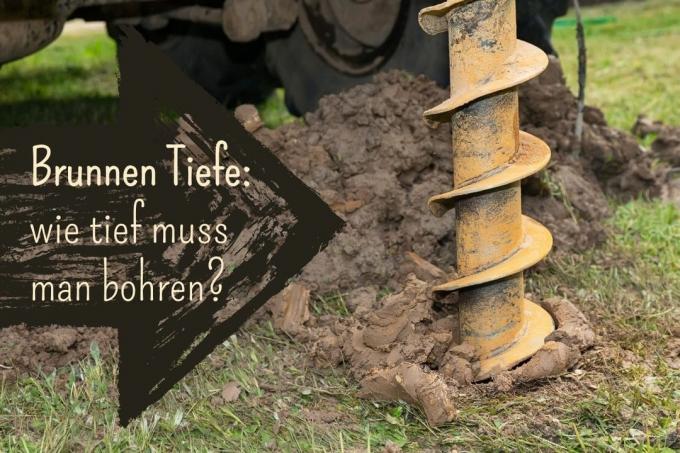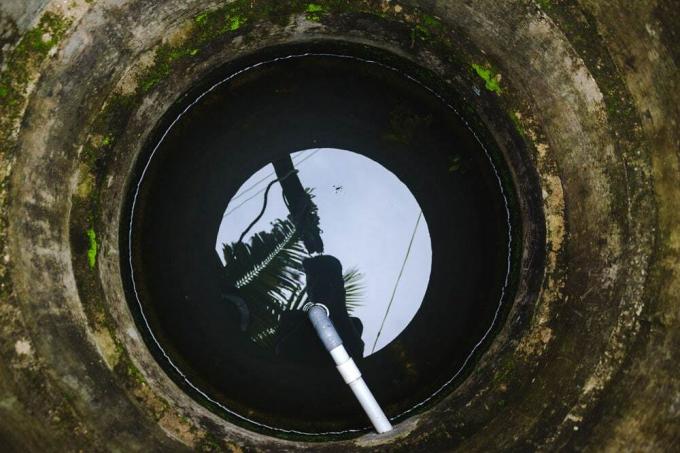
table of contents
- How deep is the groundwater?
- Drinking water or industrial water?
- Which depth is right?
- Theory and practice - the drilling permit
- frequently asked Questions
In addition to using rainwater, your own well is a good way of saving drinking water and supplying your own garden. But to what depth do you actually have to drill?
In a nutshell
- the necessary drilling depth depends on the groundwater level
- the groundwater level varies greatly from one subsurface to another
- each borehole must be applied for and approved in advance
How deep is the groundwater?
The question of the necessary depth for your production well can first of all be answered very easily: You have to drill deep enough to reach the groundwater.
Well, it's not that simple. Because how deep is the groundwater? And where can I get this information?
How far you have to get to a water-bearing layer in the ground depends on a wide variety of factors:

- Close to open water, such as rivers or lakes (the closer, the more shallow the drilling depth)
- geological conditions (e.g. B. heavily seepage subsoil - lower groundwater level)
- topographical nature of the drilling site (slopes or altitudes usually with great drilling depth)
- Weather (falling water table in dry years)
The best thing to do is to find out more from your local authority for water management and soil protection. Because all known information on groundwater levels, soil conditions and other relevant framework conditions are collected here.
Drinking water or industrial water?
Another factor for the “correct” drilling depth of your well is the way in which you extract it water want to use later. For simple garden irrigation, it is sufficient if you simply reach groundwater at all. For use as drinking water, however, you should penetrate to greater depths, as the surface water so has more time after seeping through different layers of soil and to itself clean.
Note: In Germany, drilling a drinking water well is only permitted in exceptional cases. Normally, drinking water has to be obtained from the public supply network.
Which depth is right?
Of course, you also want to know the figures, what depths and, of course, what effort you have to reckon with for your well. If the groundwater levels are very high, i.e. near a river, you can come across groundwater after just a few meters. Nevertheless, penetrate at least three to four meters deep in order to avoid the fluctuations close to the surface that always occur even on very damp surfaces. At low groundwater levels, however, it can also happen that you have to penetrate well into the two-digit meter range. It is important that you don't just “start drilling” until you hit water. Obtain clear guidelines from the aforementioned competent office as to how deep your advance must be in order to ensure that the removal is as permanent as possible.
Note: Make your boreholes so that there is at least around 2 meters of water above the extraction point. Then the weight of the water supports the suction process of your pump. Your technique will thank you in the long run.

Theory and practice - the drilling permit
You have now met the Office for Water Management and Soil Protection as the competent authority twice. In addition to the function of an information center, this office also has another, far more important task: It is the authority responsible for issuing the permit required for your well. Because in Germany you need a permit for every drilling into the subsoil and every extraction of water.
Typically, you will need to include the following information with your application:
- Position of the hole
- Planned depth (usually in agreement with the office)
- Withdrawal amount
- purpose of use
- Technical information on the borehole and well
frequently asked Questions
As the basis of our water supply, groundwater enjoys a high protection status. Private boreholes are only allowed if their extraction does not lead to fear of impairment of the soil, groundwater level or water quality.
The pumping of drinking water from one's own well is only permitted if the supply is removed from the public pipeline network. The background to this is the enormous effort with which the quality of your pumped water, which is prescribed for drinking water, has to be checked and ensured.
The effort required for drilling alone varies greatly depending on the depth required. If you only drill a few meters, a simple manual drill may be sufficient. Over 10 meters, an elaborate drilling rig, usually mounted on an excavator, is indispensable. The costs are then based on the rental fees and possible fees for specialist staff. Contact a qualified drilling company at an early stage and let them make you an offer.
